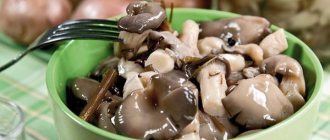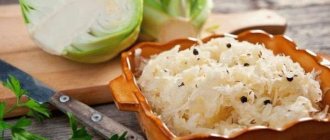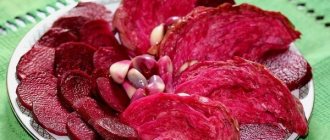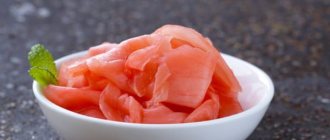Which cabbage is better to choose?
Cabbage is fermented in almost every home, regardless of whether you have your own garden or buy vegetables at the market. But not any cabbage is suitable for pickling. In order not to be disappointed with the result of your labor and the taste of the final product, you should carefully choose a vegetable. Medium and late ripening varieties that have sufficient dry matter and denser leaf mass are suitable for pickling and pickling. Early varieties do not meet these criteria and are not suitable for pickling.
The heads of cabbage should be large in size, dense, not loose (the tighter the forks, the whiter and more tender the leaves inside), white in cross section (this indicates the presence of more sugar, which affects the fermentation process during fermentation), the taste of the head of cabbage is when fresh it should be sweet and crunchy. The stalk should also be elastic and juicy. When choosing cabbage in late autumn, you need to make sure that it is not frostbitten.
Mid-season varieties for pickling:
- Slava - ripens in 113–119 days, fruit - up to 5 kg;
- Gift - ripens in 120–135 days, fruit - up to 5 kg, with a spicy-spicy sourness;
- Anniversary F1 - ripens in 90–95 days, fruit – 2.5–4 kg;
- Dobrovodskaya - ripening on the 110th day, fruit - 10-11 kg, wonderful taste;
- Belorussian - ripens in 120-130 days, fruit - 3-4 kg, it is better to ferment immediately after harvest.
Late varieties for pickling:
- Turkis - ripens in 150-165 days, it is better to ferment closer to winter, fruit - 3-4 kg;
- Geneva F1 - should be fermented at the end of winter or early spring, fruit - 3-4 kg;
- Amager - harvested after 150-175 days, fruit - 2.4-4 kg, taste bitter in autumn, improves with time;
- Snow White, - ripening period - 145-160 days, fruit - 2.5-3.9 kg.
Hybrid varieties are also popular when choosing for pickling; variety selection is aimed at obtaining larger heads of cabbage:
- Moscow late-15 - ripens in 115-140 days, fruit - 10-18 kg;
- Kolobok - ripening in 150 days, fruit - over 5 kg;
- Menza F1 - ripens in 110–115 days, fruit – 5–9 kg;
You can also ferment red cabbage. It has coarser fiber and a bitter taste.
When is the best time to ferment?
It is recommended to ferment cabbage in two periods - autumn and winter.
in autumn
As soon as the harvest of mid-season and mid-late varieties of vegetables begins in the fields, the first stage of cabbage fermentation begins. Medium-ripening varieties can be fermented as early as September, but the finished product should be stored in a cold room. At the first frost, mid-late varieties can be fermented. By this time, the amount of sugars in them will increase, which improves the quality of fermentation and the taste of the product.
in winter
Late varieties are suitable for long-term fresh storage. But heads of cabbage that are not intended for storage are recommended to be processed 2-3 months after collection - in November or December. During this time, sugar accumulates in the leaves and they become juicier. If you ferment such varieties earlier, the finished product will acquire an unpleasant odor and bitter taste.
Features of sourdough
There are two types of cabbage starter:
- Salting - pour brine at room temperature. This method is simpler and salting is faster.
- Pickling takes place without salt or with minimal salt content.
Preparing vegetables for fermentation occurs in the following order:
- Cleaning - remove the top green leaves and cut out the stalk, which can be used if the cabbage is grown on your own plot without the use of chemicals.
- Shredding - chopping with a knife or using a shredder. The chips should not be very thin, otherwise the product will turn out soft.
- Loading containers - load the chopped mass into the selected and prepared container not to the top, so that the juice does not leak out in the first days of ripening. Loss of juice leads to a deterioration in the quality of the finished product.
- Tamping - cabbage placed in a container is lightly compacted until juice appears.
- Adding salt - each layer of cabbage is seasoned with coarse salt, evenly distributing its amount over the number of intended layers.
- Installing the oppression - after filling the container, the top layer is covered with large cabbage leaves, a clean cloth napkin and the oppression is installed.
There are several types of sauerkraut:
- shredded - chips no more than 5 mm;
- chopped - shavings no more than 12 mm;
- whole cabbage - whole forks are sprinkled with shredded or chopped cabbage, and a cross-shaped cut on the stalk will allow the cabbage to be salted faster.
The main component when sauerkraut is sauerkraut is carrots. It can be grated or cut into strips. Grated carrots will turn the cabbage orange, while chopped carrots will leave it white. Additional ingredients will give the finished product a pleasant color and unique aroma: red cabbage, beets, sweet bell peppers, chopped apples, dill and caraway seeds, bay leaves. Adding horseradish root will make the cabbage crispy.
Which container is best for pickling?
Before fermentation, you need to carefully prepare the container. At home, glass jars, enamel buckets and pans (without damaging the enamel), ceramic and wooden containers are useful for pickling. Ideal wooden containers are oak, birch, linden, worse - spruce. You cannot use plastic containers, stainless steel or aluminum containers.
How long should it ferment?
The first signs of fermentation are gas bubbles and foam on the surface. They need to be removed. This technique should not be neglected, since otherwise the taste of the finished product will deteriorate. To remove gases from the inner layers, it is necessary to make punctures twice a day with a smooth wooden skewer to the bottom of the container. Punctures are carried out until the unpleasant odor disappears.
Vigorous fermentation takes place within 5–6 days at a temperature of +18…+21°C. This temperature regime helps preserve vitamin C and suppress microbial processes through the rapid formation of acid. After this period ends, the containers must be moved to a cool room to slow down the fermentation processes.
Cabbage fermented at a temperature of +21°C has the best taste. By the fifth day, it acquires the optimal ratio of acid and sugar, which gives it a pleasant salty-wine taste. With further fermentation, cabbage acquires a sharper taste, which can be described as sour and salty.
At temperatures below +18°C, the fermentation process slows down and lasts up to 1–2 months. At high temperatures (about +30°C), warm fermentation will end in a week, but the quality of the resulting product in color and taste will be inferior to the product of long-term fermentation.
When to put pressure
A weight is a special object of a given mass, which is placed on top of fermented vegetables as a load. Cabbage must be fermented under pressure. The weight of the load should be such that the contents of the container are completely covered with brine. The amount of pressure can be adjusted depending on the amount of juice released.
At the beginning of fermentation, the load can be large for better juice release. The load can then be reduced. Jars filled with water or clean pebble stone (in no case limestone) are suitable as oppression. Metal objects cannot be used as oppression.
Step-by-step instructions for fermenting cabbage
- Prepare the dishes for fermentation : wash and dry, put currant branches with leaves and dill on the bottom.
- Chop the cabbage , grate the carrots on a coarse grater, cut the apples into thin slices.
- Mix cabbage with salt , carrots, grind until juice appears, put in a bowl, layering with apples in the above proportions. Instead of apples, you can add layers of currant leaves and dill.
- Tamp down , cover with whole cabbage leaves on top, put a cotton napkin and press with pressure (the weight of the pressure is 15% of the weight of the product).
- Leave the container for 2-3 days at a temperature of 15-20 ° C for fermentation . During the process, juice, foam, and gases will be released. To release the gas, you need to pierce the vegetable layer with a stick, and pour the excess liquid into a separate container, and then add it back again.
- After 2-3 days, when fermentation is over, the pressure can be loosened and the product can be refrigerated . During storage, be careful to ensure that the brine covers the vegetables at all times.
There are quite a lot of options for vegetable and spicy additives that affect the taste and appearance of cabbage pickles. So, many people like to sprinkle layers of cabbage with beets, others like to use raw pumpkin instead of carrots, and still others are delighted with how delicious it turns out if you put halves or quarters of a head of cabbage in the cabbage. Often bay leaf, cumin, black and allspice are added to the pickle.
Sometimes leavening cabbage leaves excess brine. Under no circumstances should you pour it out, because it is rich in vitamins and minerals and is a wonderful refreshing drink. It should be preserved and left for future use: strain, heat in a saucepan to 85°C, pour into heated containers, pasteurize for 20 minutes. After cooling, store in a cool place.
Where can I store it?
To preserve quality and taste, the optimal storage temperature must be maintained at 0...+2°C, while it will be possible to maintain the chemical composition at the level of the end of fermentation. A cool basement or cellar can provide this temperature. If there are no such conditions, then you can store it in the refrigerator or on a glassed-in balcony, or ferment the cabbage in small portions to eat it faster. At elevated storage temperatures, the acidity of cabbage decreases and it loses its elasticity.
Possible problems during fermentation
To get the perfect fermentation product, you need to know about possible errors and how to correct them:
- The appearance of foam is a natural process at the beginning of fermentation and requires only timely removal.
- Bitter taste - when preparing the raw materials, green leaves were left and the protruding foam was not removed.
- Dark and light layers - uneven distribution of salt when the layers are salted; in places with a lot of salt, the cabbage becomes dark.
- Flabbiness - insufficient salt. The best proportion is 200 g of salt per 10 kg of prepared raw materials.
- Mucus - violation of fermentation temperature conditions, addition of iodized salt, excess sugar or carrots, chemicals in vegetables.
- Pink color - excess salt, loose compaction, the product acquires a musty taste.
- Film on the surface - low storage temperature. It is necessary to remove and wash the cloth and oppression.
- Mold - moldy fungi and yeasts develop on the surface under the influence of oxygen. The top layer must be removed and discarded. Horseradish leaves placed on the surface will help avoid mold.
- Hard cabbage - poorly bruised, too much salt, slightly oppressive.
With the onset of cold weather, the most common winter snack appears on the tables - sauerkraut. To ensure that the final product does not bring disappointment, it is necessary to follow the fermentation and storage technology. In this case, sauerkraut will be a pleasure both as an independent snack and as an ingredient in the preparation of second and first courses.
How to cut cabbage for pickling
According to the ancient custom, in preparation for pickling, heads of cabbage were chopped using cleavers in a special wooden trough. The taste of chopped cabbage is different from shredded cabbage. The secret is that when chopping, cabbage juice is formed in the trough, which is used for sourdough. To get this effect, the heads of cabbage can be chopped in a vegetable cutter or food processor.
How to cut cabbage for pickling
The juice will remain in the bowl. If you use a knife and a cutting board, then you can create this effect by randomly cutting the head of cabbage into medium-sized pieces of irregular shape. The second feature is the amount of salt that is used for sourdough. Less salt is added to chopped cabbage.
Today, for shredding, a sharp knife or with two blades, specially designed for this purpose, is used. Shred on graters with attachments of different widths. Cut with electric vegetable cutters or food processor. This simplifies the process and saves time on preparation. In the classic version, the head of cabbage is cut into finger-thick strips.
How many days does it take to salt and ferment cabbage? How much time?
The time for ripening cabbage in the classic way (shredded cabbage and carrots and salt, in your own brine) is from 1.5 days to a week, and depends on several factors:
- varieties of cabbage (thin-leaved cabbage ferments faster);
- room temperature;
- amount of salt (less salt means faster ripening);
- taste preferences (for example, I like lightly salted and sour);
- place and period of its further storage.
You need to check the condition of the cabbage daily and taste it. An experienced housewife will immediately understand when cabbage needs to be put in a cold place.
If you plan to eat cabbage right away, you can ferment it in the room a little longer.
If the cabbage “goes” for long-term storage and stands at above-zero temperatures, for example, in a refrigerator or cellar, then it can be put there earlier, it will gradually sour.
If the cabbage will be stored in the cold, then you need to ferment it in the room longer (it will not sour in the cold).
Salting time depends on several factors.
This is the thickness of the cabbage shredder - the thicker it is, the more time it takes for the cabbage to salt.
Cabbage variety. Late-ripening varieties have a denser consistency than mid- or early-ripening varieties.
Well, everyone has different tastes. Some people like it sour, which means keeping it for 3-5 days. And some people like cabbage that is not very salty. Then 2 days is enough.
It depends on who likes what kind of cabbage. This determines how many days you need to keep it in a warm room, allowing it to ferment. I don’t like cabbage that is too sour, so if I salt it (which happens very rarely), I keep it in a warm kitchen for no more than two or three days.
Finely shredded cabbage will, of course, be salted faster. I usually also add finely chopped carrots and dill seeds. It gives a special taste and smell to cabbage. But who doesn’t like dill, of course, pickle it without seeds. Salt, mix, put in a jar quite tightly.
I put the jar in a cup so that the leaking juice does not fall on the table. We pierce the thickness of the cabbage several times a day so that the gases formed during fermentation escape.
Let's try. And if the taste is normal, then after two or three days you can take it out to a cold place.
P.S. Cabbage turns out delicious if you add chopped beets to it. And just eat it and cook the borscht.
Usually three days are enough. Ambient temperature also plays a role. When it’s warm, cabbage ferments faster; in cold weather, it ferments slower. In any case, the cabbage will be ready within a week. When the cabbage has already become sauerkraut, it needs to be put in a cold place (cellar or refrigerator). You need to make sure that the liquid covers the cabbage completely, otherwise the sauerkraut will darken.
It all depends on the recipe you took. If the natural salting is only cabbage. carrots and salt - three days for sure.
1 tbsp black peppercorns
6 bay leaves
2.5 tbsp salt
Shred the cabbage and carrots on a grater, mix. Add the pepper and tamp it into a jar, sometimes transfer it with a laurel leaf. then add water (so that the cabbage does not dry out). and place the jar in a bowl (so that the excess liquid is drained into the bowl. After three days, you can try. If the cabbage and carrots are soybean, they will release juice immediately and you will not have to add water on top.
If you add honey during fermentation, you can eat the cabbage the very next day!
Chop the cabbage and carrots, compact them into a jar and fill them with brine: boil water (0.5 l), add honey (1.5 tbsp) and salt (3.5 tbsp). And pour it warm into the jar and cover it with a lid (but don’t close it). Periodically pierce the cabbage with a skewer. so that excess air comes out) the next day you can eat cabbage.
Answers:
#1 It’s worth noting right away that when sauerkraut is cooked it will be smaller in volume than it was in its raw form.
The calculation is approximately this: from 12 kilograms of fresh cabbage you can get about 10 kilograms of sauerkraut. #2 During sauerkraut, the cabbage will release juice, which can be used to determine the readiness of the sauerkraut. This juice, or rather the brine, will foam at the very beginning as the fermentation process occurs. As soon as it becomes noticeable that the foam has disappeared from the surface of the brine, and the brine itself no longer rises and has become lighter, this indicates that the cabbage is ready.
#3 Another indicator that the cabbage is already cooked is its taste. The finished cabbage should have a sour-salty and at the same time refreshing taste. It should also crunch on your teeth. All these components indicate that the fermentation process of cabbage has ended and it can be safely eaten.
#4 Now you just need to take care of its proper storage. To do this, the cabbage is compacted well and pressure is placed on top. This cabbage should be stored in a cool place where the temperature does not exceed 10 degrees.
#5 You can highlight approximate time guidelines for how to determine the readiness of sauerkraut. Everything will depend on what container and in what volume the cabbage is fermented. This plays a big role in determining the cooking time.
#6 So, if cabbage is fermented in a large enough saucepan, it will take six days to be ready. If you salt the cabbage in a three-liter jar, then the whole process will take exactly half as much time. After this time, you need to taste the cabbage and make sure that it is safe to eat.
#7 If the cabbage tastes too soft and does not crunch, it means there is not enough salt in it. Unfortunately, nothing can be done about this now. In order for the period during which the cabbage ferments to last longer, and thereby the cabbage to be stored for longer, you need to put it in the refrigerator from the very beginning of preparation.
#8 If mucus appears on the cabbage, then it is better not to eat it in its natural form. But it is quite possible to use it for preparing borscht and other dishes where it will undergo heat treatment. It is also worth noting that in the first days of pickling cabbage, all the nitrates contained in it are converted into nitrites. Therefore, you can eat cabbage only a week after pickling.
- How many days will it take for sauerkraut to be ready?
- How long to keep pressure on cabbage
- Three-day sauerkraut
In order for the cabbage to ferment/pickle without turning sour, and it can be stored in a cool place, it is important to carry out the fermentation procedure correctly. As for the timing when a vegetable can already be eaten, this factor depends on three components:
- cabbage varieties;
- amount of salt;
- temperature conditions.
Now a little more about each factor. So, late-ripening vegetables are best suited for pickling; the ideal option is white cabbage of rounded-flattened varieties. The fact is that these varieties are the most juicy; when fermented, they release a lot of juice.
Salt is an important component when salting, because the taste of the finished product and the duration of its storage depend on its quantity. It is believed that the most optimal amount of salt for pickling is 2% of the weight of cabbage, that is, for one kilogram of chopped vegetables it is best to take 20 grams of salt (about a tablespoon).
Features of sauerkraut at home
The first experience of sauerkraut at home may end in failure if you do not know the secrets that are well known to experienced housewives:
- Not all varieties of cabbage are suitable for pickling. The harvest collected in summer is not suitable for home preparation. It is better to ferment late varieties, giving preference to the juiciest ones, whose heads are almost completely white. One of the most popular varieties for fermentation is “Slava”, it is suitable for dry fermentation. “Kolobok” and “Amager” are best salted in brine.
- You need to cut the cabbage for fermentation with a sharp knife designed for shredding. But it is better to make the pieces not very thin, but about 5 mm. If you ferment thin, small pieces, they will become too soft, but sauerkraut tastes much better when it remains crunchy.
- You can ferment cabbage at home in an enamel pan, bucket, or in glass jars. If possible, you can try fermenting cabbage in an oak tub or barrel - it will acquire a unique taste. However, this method is only suitable for those who have a cold cellar for storing pickles. Aluminum containers are not suitable in any case, since this material reacts with lactic acid, which is formed during the fermentation of vegetables.
- Sauerkraut is fermented at room temperature or slightly below it. If the room temperature rises above 24 degrees, the cabbage may become slippery. At temperatures below 20 degrees, fermentation will not proceed intensively enough.
- In order for enough juice to be released, the cabbage must be placed under pressure or compacted very well. This is especially true when sauerkraut is dry-cooked.
- During fermentation, the cabbage must be pierced from time to time with a long, sharp knife to release gases. Otherwise, the finished snack will not have the most pleasant smell.
- Pickling cabbage at room temperature lasts 3 days, then you can eat it, but it will still taste better a little later: classic recipes call for fermentation for a week.
- It is best to store sauerkraut at a temperature of 0 to 2 degrees, so the cellar and refrigerator are ideal places for this. If necessary, cabbage can be frozen. To do this, you need to put it in bags and put it in the freezer. It is advisable to make portions not very large, since cabbage cannot be re-frozen. For the same reason, the balcony is not the most suitable place for storing sauerkraut at home.
- During storage, mold may form on cabbage. Mustard and sugar, which can be sprinkled on the workpiece at least once a month, help prevent its appearance.
When properly prepared and stored, sauerkraut can be eaten for 9 months after preparation. The fresher it is, the tastier it is, which is why it usually doesn’t sit out for so long.
Adviсe
Remember the section “notes for the hostess”? There were always tips that made cooking easier. Now I will tell you how to act to avoid mistakes.
It is important to cut correctly and select the proportions of ingredients. If you find a recipe, then don't experiment. Do not deviate from the established proportions. If after tasting you want to add something, then adjust the recipe.
Carrots should be cut as much as indicated in the recipe.
I recommend trying cabbage in tomato juice. This is a great appetizer that will last all season. Cut the cabbage leaves into 6 mm strips. Do not take the rough parts of the head of cabbage. They do not turn out as juicy and tender as the leaves.
The secret to this recipe is coarse rock salt. It will help fermentation occur within the time frame we need.
Do not touch the cabbage or pierce it with a fork for three days. The gases formed as a result of fermentation will begin to escape on their own, indicating the degree of readiness of the product. Usually the head of cabbage ferments for up to 5 days; the temperature is +25 °C.
Is it possible to speed up the fermentation process?
This can be done at room temperature. How? We need to remember a little chemistry lessons. If you add more sugar to the tub, the glucose will begin to interact with acids. As a result, fermentation will speed up. Be sure to look at the temperature in the room. The warmer it is, the more efficiently the cabbage ferments.
Classic sauerkraut recipe: dry method
- white cabbage – 4 kg;
- carrots – 0.4 kg;
- salt – 80 g;
- sugar – 80 g.
- Wash the cabbage and remove the top leaves. Chop into strips of 3–4 mm.
- Peel the carrots and grate them on a coarse grater. If desired, you can grate it to make Korean salads.
- Mix the cabbage and salt thoroughly, crushing it with your hands.
- Sprinkle with carrots and sugar and stir.
- Fill the container in which you are going to ferment the cabbage. A five-liter saucepan or a clean glass jar of the same capacity is suitable for this purpose.
- When laying cabbage, compact it often with your hands or even your fist. Place the container in the basin, as a lot of juice will soon be released. Cover the cabbage with clean gauze; if possible, place a weight on top (when fermenting in a jar, you can do without pressure). Leave at room temperature for 3 days. Twice a day skim off the foam, rinse the gauze and pierce the cabbage with a knife.
- Move the container to a cooler place (unheated pantry, on the loggia, if there is no frost outside) and wait another 4 days.
- Place the cabbage in containers convenient for its further storage at home (if desired, you can store it in the same place you fermented it in). Put it in the basement or refrigerator. Don't forget that sauerkraut can also be stored in the freezer.
This recipe produces crispy cabbage with a slight sourness. There is no need to rinse or soak it before serving – you just need to pour some oil on it.
If it’s still salting
Now that the choice has been made, all that remains is to find a suitable recipe. And here is the so-called cabbage in instant brine. The following ingredients will be required:
- cabbage (white) - 2.0 - 2.5 kg;
- medium carrots - 3 pieces;
- garlic - 5 - 6 cloves;
- water - 1 l;
- rock salt (not iodized) - 2 tablespoons;
- granulated sugar - 100 g;
- vinegar 9% - 100 g;
- vegetable oil - 150 gr.
Now let’s learn how to quickly pickle cabbage. First of all, chop the vegetable itself, grate the carrots on a coarse grater and cut the garlic into thin slices. Mix the salad well and place in a glass jar.
It's time for the marinade. Pour water into an enamel pan, add salt, sugar and bring to a boil. Remove the dishes from the heat, add the bite and vegetable oil. Fans can take aromatic oil pressed from roasted seeds. Mix the marinade. This quick way of salting cabbage requires pouring hot brine over the vegetable mixture prepared in a jar.
Leave your piece of culinary art to cool and then place it in the refrigerator. The preparation time for such a masterpiece is no more than 50 - 60 minutes.
Korean recipe
Nowadays, salads under the general name “Korean style” are very popular. This is also a recipe for quick pickled cabbage. So, it has the following composition:
- 2 kg cabbage;
- 4 medium sized carrots;
- 125 grams of cold boiled water;
- 1 glass of vinegar 9%;
- 1 glass of vegetable oil;
- 1 cup of sugar;
- 2 tbsp salt;
- 2 tablespoons of Khmeli-Suneli seasoning;
- 1 teaspoon red hot pepper;
- 1 head of garlic
Let's start by chopping cabbage and carrots with a knife and on a coarse grater, respectively. Stir and set aside. Start preparing the marinade. Pour water, vinegar, and vegetable oil into an enamel pan. Add sugar, salt, seasoning, pepper here, and squeeze the pre-peeled garlic through a press.
Mix thoroughly until the sugar and salt are completely dissolved, and then add the prepared vegetables. Once again, now everything is together, mix and let it brew for about 30 - 40 minutes. Some people prefer to insist longer - up to 6 hours.
Salt “vegetable mix”
There is also a dish for those who would like to get a sort of vegetable mix together with cabbage. This option will also satisfy those who would like to quickly salt the cabbage so that it is crunchy and attractive in appearance. This salad will decorate even a holiday table and will undoubtedly become one of the favorites for most. And here it is and its components:
- 2 kg cabbage;
- 1 kg carrots;
- 1 kg sweet pepper (different colors);
- 600 grams of onion;
- 0.5 cups sugar;
- 400 g vinegar 9%;
- salt to taste.
Initially, you need to prepare all the vegetables. Chop the cabbage with a knife or shredder, grate the carrots on a coarse grater, cut the sweet pepper into thin strips, and cut the onion into half rings. Mix in a bowl of the required volume, add salt to taste and add sugar and vinegar. That's it - the salad is ready, you can start tasting. Well, and most importantly, don’t forget to put the part that survived after this absorption into a glass jar and hide it in the refrigerator. It is doubtful that it will have time to deteriorate, but summer is summer.
Preparing the pelyuska
Among those who like to eat salted cabbage, there will also be incorrigible cabbage fans - pelyustas. They are so attracted by the opportunity to take it in pieces, and sometimes separate them and enjoy with pleasure this miracle created by the skilled sorceresses of Russian cuisine. It is for them that the following salting recipe is quite quick. For it you will need:
- cabbage;
- 1 liter of water;
- 1 cup of sugar;
- 1 glass of vinegar 9%;
- 0.5 cups refined oil;
- 2 tbsp salt.
This salting involves cutting a healthy vegetable into pieces. You can cut the forks into 8 pieces, or you can cut them 3-4 times smaller. Who likes it how? Place the resulting slices in an enamel pan. Next, the marinade is prepared. Pour water into a separate bowl, add sugar and salt. Boil, reduce heat. Pour vinegar and oil into the resulting solution and let the brine boil a little.
Pour the resulting marinade over the previously prepared cabbage and leave at room temperature overnight until the morning. When you wake up in the morning, you can enjoy your favorite dish.
A simple recipe for sauerkraut in brine
- cabbage – 2 kg;
- carrots – 0.2 kg;
- water – 1.5 l;
- salt – 50 g;
- sugar – 50 g;
- bay leaf – 1 pc.;
- black peppercorns – 3 pcs.
- Wash the vegetables. Chop the cabbage and grate the carrots.
- Mix cabbage with carrots, put in a jar, compacting it carefully.
- Boil water, dissolve salt and sugar in it.
- Place bay leaves and peppercorns on top of the cabbage.
- Place the jar in a plate, pour hot brine over the cabbage until it overflows.
- Leave it in the room for 3 days, piercing the cabbage several times a day to release the unpleasant-smelling gases produced during fermentation.
- Transfer the cabbage to smaller jars, fill with the remaining brine and store in a cool place. At home, this place is usually the refrigerator, although some people store pickles in the basement.
Cabbage in brine is prepared simply and quickly, even for inexperienced housewives.
Sauerkraut with apples and lingonberries
- cabbage – 3.5 kg;
- sour apples (ideally Antonov) – 1 kg;
- carrots – 0.3 kg;
- lingonberries (can be replaced with cranberries) – 100 g;
- rye bread (crackers) – 100 g;
- juniper berries – 5-6 pcs.;
- cumin (seeds) – 5 g;
- sugar – 60 g;
- salt – 80 g;
- currant leaves – 5-6 pcs.;
- vodka – 70 ml.
- Prepare a container for sauerkraut. Two three-liter jars or a large saucepan of 6-7 liters will do. An enamel bucket and an oak tub are also suitable containers. The selected container must be washed well and doused with boiling water.
- Place cabbage leaves at the bottom of the tub (or other container), after washing them first. Place half of the currant leaves and a crust of bread there.
- Chop the cabbage, mix it with salt and wait until the juice starts to release.
- Add sugar, grated carrots and cumin seeds, stir.
- Wash the apples, cut into several parts, cut out the core.
- Add a layer of cabbage, filling the container about a third full. Compact it well.
- Add half the apples, juniper berries, and remaining currant leaves.
- Lay out the rest of the cabbage and tamp it down thoroughly.
- Add the remaining apples and sprinkle the lingonberries. Cover with gauze or a clean cloth. Pour vodka over the cabbage and leave to ferment at a temperature of 18–22 degrees for 5–7 days. Pierce the cabbage regularly with a knife or long-handled wooden spoon.
- Store in a cool place.
There is no shame in serving cabbage pickled according to this ancient recipe even at the holiday table.
Spicy sauerkraut with beets, horseradish, garlic
- cabbage – 4 kg;
- beets 0.4 kg;
- garlic – 2 heads;
- grated horseradish root – 30 g;
- sugar – 60 g;
- salt – 80 g;
- water – 1 l.
- Peel the raw beets, wash them, cut them into large pieces and grate them using a regular grater or a Korean salad grater.
- Pass the garlic through a press.
- Grate the horseradish.
- Finely chop the cabbage.
- Mix cabbage with horseradish, beets and garlic.
- Boil water, dissolving salt and sugar in it.
- Place the cabbage in a fermentation container (you can put it in jars). Place the container itself on a large plate or in a basin.
- Carefully press down the cabbage so that it lies as tightly as possible.
- Pour hot brine over the cabbage.
- If the size of the container allows, place a plate on top of the cabbage and place a weight on it (for example, a jar filled with water).
- 2-3 times a day for a week, remove the load and pierce the cabbage in several places to release the gas formed during fermentation.
- After 7 days, put the cabbage in jars and put it in the refrigerator. If the cabbage has already been fermented in jars, you can store it directly in them.
This recipe produces a spicy appetizer with a beautiful color that will appeal to lovers of savory dishes.
How to ferment cabbage so it's crispy
The fermentation method is based on the conversion of sugar under the influence of lactic acid bacteria into lactic acid. The acid plays a preservative role and prevents the development of putrefactive bacteria and butyric acid microbes. Extends the shelf life of the product.
How to ferment cabbage so it's crispy
To create a favorable environment, it is enough to fulfill three conditions:
- In order for lactic acid bacteria to have enough food, sugar is needed. Sugary varieties of cabbage are used. The less sugar, the less lactic acid is produced. Stability and shelf life are reduced.
- Creating a favorable temperature for lactic acid bacteria during fermentation is the second condition. The fermentation process proceeds successfully at temperatures of 15 - 22°. At low temperatures, the development of bacteria slows down and the fermentation process is delayed. At high temperatures, in addition to lactic acid bacteria, others also develop. For example, butyric acids. Under their influence, an unpleasant, rancid taste appears.
- The third condition is careful preparation of containers and other equipment involved in the cooking process. The dishes and equipment are thoroughly washed and scalded with boiling water.
When fermenting, salt is added. It is used for more than just taste sensations. Salt slows down the action of butyric acid bacteria and enhances the preservative properties of lactic acid.
Tender cabbage pickled with honey
- cabbage – 4.5–5 kg;
- salt – 85–90 g;
- honey – 70–75 g;
- bay leaf – 5-6 pcs.
- Chop the cabbage, mix with salt, remember and wait until the juice is released.
- Melt the honey, dissolve it in a minimum amount of water (a quarter cup).
- Pour the honey liquid over the cabbage and mix well.
- Sterilize liter or larger jars and place bay leaves on them.
- Tamp each layer down and fill the jars with cabbage, leaving enough room at the top for the cabbage juice to escape. Place the jars on plates.
- Place for 3 days in a fairly warm room (20 to 24 degrees). Prick the cabbage twice a day.
- Drain off excess juice, leaving only a small layer covering the cabbage.
- Place a wooden circle or cloth in a large saucepan. Place the jars of cabbage in the pan. Fill the pot with water until it reaches approximately the level of the cabbage in the jars.
- Place on low heat. Sterilize for 20 to 40 minutes depending on the volume of the jars.
- Remove the jars of cabbage from the pan, roll them up and turn them over.
- Wrap it up and leave it to cool like that.
- When the jars have cooled, they can be stored in the pantry.
Cabbage prepared according to this recipe will be tender. It keeps well even at room temperature. This distinguishes this method of its preparation from others.
Taste, crunch, beauty!
Sauerkraut is delicious on its own, but traditionally it is served as an appetizer, adding onion cut into thin half rings and drizzling with vegetable oil. In addition, home-sauerkraut can be used to prepare solyanka, bigos, cabbage soup and other dishes.











